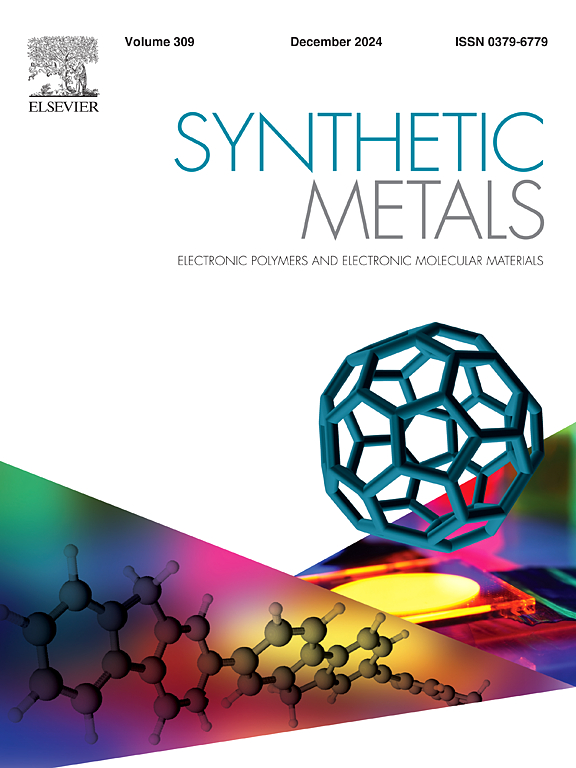Novel synthesis of reduced graphene oxide-decorated antimony sulfide nanoparticles via pulsed laser ablation in liquid for photovoltaic applications
IF 4
3区 材料科学
Q2 MATERIALS SCIENCE, MULTIDISCIPLINARY
引用次数: 0
Abstract
In this study, a novel reduced graphene oxide (rGO)-decorated antimony sulfide (Sb₂S₃) nanocomposite was successfully synthesized using the pulsed laser ablation in liquid (PLAL) technique. A 1064 nm Nd:YAG laser was employed to ablate an Sb₂S₃ target submerged in Chlorobenzene containing rGO sheets, facilitating a one-step, environmentally friendly synthesis process. The rGO-Sb₂S₃ nanocomposite exhibited improved optical absorption properties and reduced bandgap energy (1.62 eV) compared to pure Sb₂S₃ (1.90 eV) and rGO (1.32 eV), attributed to enhanced interactions between rGO and Sb₂S₃ nanoparticles. Comprehensive characterization, including UV–visible spectroscopy (UV-Vis), Fourier Transform Infrared (FTIR), micro-Raman spectroscopy, X-ray diffraction (XRD), and high-resolution transmission electron microscopy (HRTEM), confirmed the successful formation of rGO-Sb₂S₃ with well-dispersed Sb₂S₃ nanospheres (2–20 nm) anchored onto rGO sheets. The synergistic properties of rGO and Sb₂S₃, including improved charge separation and broad light absorption, make this nanocomposite a promising candidate for photocatalytic and photovoltaic applications. This work highlights the potential of PLAL for scalable, reproducible, and efficient synthesis of advanced nanocomposites for energy and environmental applications.
通过脉冲激光烧蚀液态还原氧化石墨烯装饰硫化锑纳米粒子的新合成,用于光伏应用
在这项研究中,利用脉冲激光烧蚀(PLAL)技术成功合成了一种新型的还原氧化石墨烯(rGO)修饰的硫化锑(Sb₂S₃)纳米复合材料。采用1064 nm Nd:YAG激光烧蚀含氯苯的还原氧化石墨烯片上的Sb₂S₃靶材,实现了一步环保合成。与纯Sb₂S₃(1.90 eV)和rGO (1.32 eV)相比,rGO-Sb₂S₃纳米复合材料表现出更好的光学吸收性能和更低的带隙能量(1.62 eV),这是由于rGO和Sb₂S₃纳米颗粒之间的相互作用增强了。综合表征,包括紫外可见光谱(UV-Vis)、傅里叶变换红外光谱(FTIR)、微拉曼光谱、x射线衍射(XRD)和高分辨率透射电子显微镜(HRTEM),证实了rGO-Sb₂S₃的成功形成,分散良好的Sb₂S₃纳米球(2-20 nm)固定在rGO薄片上。rGO和Sb₂S₃的协同性能,包括改进的电荷分离和广泛的光吸收,使这种纳米复合材料成为光催化和光伏应用的有希望的候选者。这项工作突出了PLAL在可扩展、可重复和高效合成先进纳米复合材料方面的潜力,可用于能源和环境应用。
本文章由计算机程序翻译,如有差异,请以英文原文为准。
求助全文
约1分钟内获得全文
求助全文
来源期刊

Synthetic Metals
工程技术-材料科学:综合
CiteScore
8.30
自引率
4.50%
发文量
189
审稿时长
33 days
期刊介绍:
This journal is an international medium for the rapid publication of original research papers, short communications and subject reviews dealing with research on and applications of electronic polymers and electronic molecular materials including novel carbon architectures. These functional materials have the properties of metals, semiconductors or magnets and are distinguishable from elemental and alloy/binary metals, semiconductors and magnets.
 求助内容:
求助内容: 应助结果提醒方式:
应助结果提醒方式:


